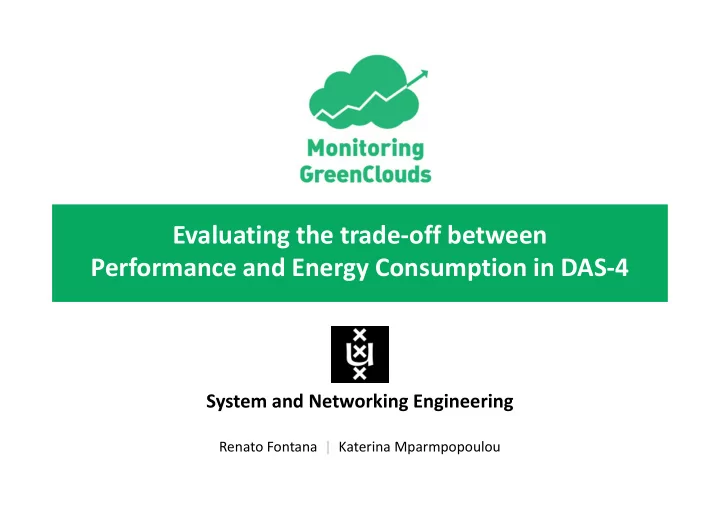

Evaluating the trade-off between Performance and Energy Consumption in DAS-4 Performance and Energy Consumption in DAS-4 System and Networking Engineering Renato Fontana | Katerina Mparmpopoulou
Presentation Flow • Green concepts • Project objective • Experimental environment • Metrics and Workload • Metrics and Workload • Experiment Results • Conclusions • Future work UvA Renato Fontana, Katerina Mparmpopoulou February 8, 2013 2 /22
Green Concepts • What does it mean to be green? • Refers to environmentally sustainable • Energy becomes a key challenge in large-scale distributed systems distributed systems • IT requires more and more power UvA Renato Fontana, Katerina Mparmpopoulou February 8, 2013 3 /22
Known techniques • Event-monitoring counters o Deducing energy consumption • On/off algorithms o Switch on/off nodes in long idle state • Load balancing o Distribute workload amongst multiple nodes • Task scheduling o Slowdown factors • Thermal management o Monitoring heat generation UvA Renato Fontana, Katerina Mparmpopoulou February 8, 2013 4 /22
Research Question • How to evaluate the trade-off between energy and performance in DAS-4? • How to correlate performance and energy • How to correlate performance and energy consumption in Cloud Computing Systems? UvA Renato Fontana, Katerina Mparmpopoulou February 8, 2013 5 /22
Approach • Compare workload with power-monitoring tools • Estimate energy consumption in nodes • Correlate main components (CPU, memory) • CPU load and energy consumed • CPU load and energy consumed UvA Renato Fontana, Katerina Mparmpopoulou February 8, 2013 6 /22
Experimental environment DAS-4 (The Distributed ASCI Supercomputer 4) • Six-cluster wide-area distributed system o UvA and VU nodes (PDU enable) • Grid Computing • Grid Computing o DAS-4 mainly composed by cluster nodes • Cloud Computing o OpenNebula UvA Renato Fontana, Katerina Mparmpopoulou February 8, 2013 7 /22
Topology Comput Cluster Head node e nodes VU fs0.das4.cs.vu.nl 001-075 LU fs1.das4.liacs.nl 101-116 fs2.das4.science.uva. UvA 201-218 nl TUD fs3.das4.tudelft.nl 301-332 fs4.das4.science.uva. UvA-MN 401-436 nl ASTRON fs5.das4.astron.nl 501-523 UvA Renato Fontana, Katerina Mparmpopoulou February 8, 2013 8 /22
Current Setup Cluster environment • 2U Twin Server • Single outlet for the entire server Rear View UvA Renato Fontana, Katerina Mparmpopoulou February 8, 2013 9 /22
Environment Approximation Cloud environment • Single node with two VMs • Only one energy source for both VMs source for both VMs • Why? • No monitoring tools; • Concurrent resource share; UvA Renato Fontana, Katerina Mparmpopoulou February 8, 2013 10 /22
Metrics and Workload Workload measurement • Bright Cluster Manager Power management • Racktivity PDUs • Racktivity PDUs Correlation of the two systems • Workload and energy UvA Renato Fontana, Katerina Mparmpopoulou February 8, 2013 11 /22
Bright Cluster Manager UvA Renato Fontana, Katerina Mparmpopoulou February 8, 2013 12 /22
Metrics Metric Extraction Method Source Execution time As reported by the Job Job Power Consumption Python Script PDU Energy Consumption Energy Consumption Python Script Python Script PDU PDU CPU Load Python script Bright Cluster Manager UvA Renato Fontana, Katerina Mparmpopoulou February 8, 2013 13 /22
Linpack Vs Polyphase Filter • Linpack lacks the configuration option to control the amount of resources that it uses • Polyphase filter is configurable, as regards the number of its runs and the used threads of its runs and the used threads • We define two different jobs; job1 and job2, so that job1 causes the double workload of job2 • We treat every single job as a unit and measure the power produced by each of them under various rates of CPU utilization UvA Renato Fontana, Katerina Mparmpopoulou February 8, 2013 14 /22
Polyphase Filter – 25% workload � job 1 is running on node-207 and the adjacent node-208 is idle CPU Load CPU Load Peak of Power Consumption Max Execution Time Node-207 Node-208 25% 0% 165,4 W 1028 sec UvA Renato Fontana, Katerina Mparmpopoulou February 8, 2013 15 /22
Polyphase Filter – 50% workload job 1 is running on node-207 and the adjacent node-208 is idle CPU Load CPU Load Peak of Power Consumption Max Execution Time Node-207 Node-208 50% 0% 184 W 587,6 sec UvA Renato Fontana, Katerina Mparmpopoulou February 8, 2013 16 /22
Polyphase Filter – 100% workload job 1 is running on node-207 and the adjacent node-208 is idle CPU Load CPU Load Peak of Power Consumption Max Execution Time Node-207 Node-208 100% 0% 190 W 530,3 sec UvA Renato Fontana, Katerina Mparmpopoulou February 8, 2013 17 /22
Results evaluation To evaluate the trade-off between power consumption and performance for all the above cases, we built a coupled in time coupled in time environment of 1200 sec CPU Load CPU Load Average Power Consumption Max Execution Time Node-207 Node-208 In time interval equal to 1200 sec 25% 0% 161,30 W 1028 sec 50% 0% 162,54 W 587,6 sec 100% 0% 162,62 W 530,3 sec UvA Renato Fontana, Katerina Mparmpopoulou February 8, 2013 18 /22
Results evaluation Finally in a short time interval, approximately equal to the longer execution time, gains in power saving are almost negligible. job2 = ½ job1 CPU Load CPU Load Average Power Consumption Max Execution Time Node-207 Node-208 In time interval equal to 1200 sec 25% 25% 161,27 W 515,4 sec 50% 50% 163,14 W 294.9 sec 100% 100% 164,39 W 269,5 sec UvA Renato Fontana, Katerina Mparmpopoulou February 8, 2013 19 /22
Conclusions • Definite execution time job o Better performance using roughly the same amout of power o Grant execution in available nodes which share the same physical server the same physical server • In the current cluster implementation, it is impossible to execute more then one job at a time o Queue system UvA Renato Fontana, Katerina Mparmpopoulou February 8, 2013 20 /22
Future work UvA Renato Fontana, Katerina Mparmpopoulou February 8, 2013 21 /22
Questions?
Recommend
More recommend